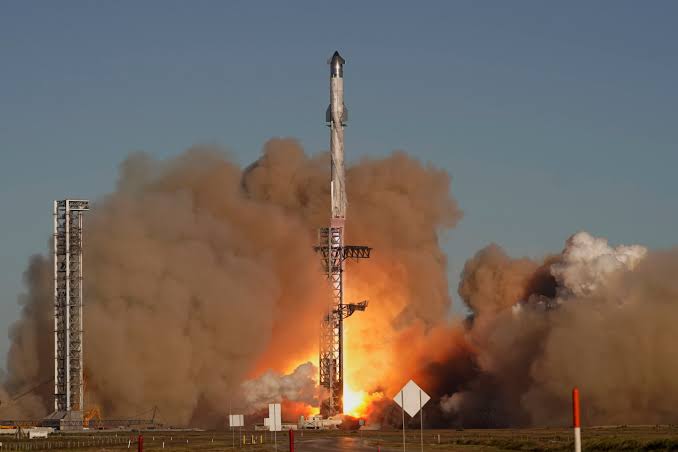Tragedy Strikes: SpaceX Starship Test Flight Ends in Catastrophic Failure
Date: January 16, 2025
In a devastating turn of events, SpaceX’s latest test flight of its Starship spacecraft ended in catastrophic failure, marking a significant setback for the company’s ambitious space exploration endeavors. The incident occurred during the seventh test flight of the Starship prototype, designated Ship 33, which launched from SpaceX’s Starbase facility in South Texas.
Launch and Initial Success
The mission commenced at 4:37 p.m. CST, with the colossal Starship rocket, standing over 400 feet tall, lifting off the pad powered by its 33 Raptor engines. The initial phase of the flight appeared nominal, with the Super Heavy booster, designated Booster 14, performing as expected. Approximately two minutes and 40 seconds into the flight, the Starship spacecraft, Ship 33, ignited its six Raptor engines and successfully separated from the booster. The booster then executed a flip maneuver and initiated a burn to return to the launch site, culminating in a successful catch by the launch tower’s mechanical arms, known as “chopsticks,” marking a significant achievement in SpaceX’s reusability efforts. citeturn0search4
Mid-Flight Anomalies and Catastrophic Failure
However, the success was short-lived. Approximately seven minutes and 39 seconds into the flight, telemetry data indicated the first sign of trouble as one of Ship 33’s center engines shut down unexpectedly. This was followed by a series of cascading engine failures: a second center engine at eight minutes and two seconds, an outer Raptor Vacuum engine at eight minutes and four seconds, and another RVac engine at eight minutes and 18 seconds. By eight minutes and 24 seconds into the flight, all gimbaling center engines had failed, leading to a complete loss of communication at eight minutes and 26 seconds, when the spacecraft had reached an altitude of approximately 146 kilometers. citeturn0search19
Tragically, around three minutes later, Ship 33 exploded over the Turks and Caicos Islands. Debris from the explosion rained down over the Caribbean, affecting areas including Puerto Rico and the British Virgin Islands. While no injuries were reported, the falling debris caused minor damage to infrastructure in Puerto Rico and the British Virgin Islands and prompted temporary airspace closures in the region, disrupting commercial flights and causing widespread concern among residents. citeturn0search19
Preliminary Investigations and Speculated Causes
In the aftermath of the incident, SpaceX CEO Elon Musk provided initial insights into the potential cause of the failure. He indicated that a propellant leak might have occurred in the cavity above the ship’s engine firewall, leading to a pressure buildup that exceeded the venting capacity. This overpressure could have resulted in the subsequent engine failures and the eventual destruction of the spacecraft. Musk emphasized the need for thorough inspections to detect leaks, the addition of fire suppression systems in critical areas, and an increase in venting capacity to prevent similar incidents in future flights. citeturn0search4
Regulatory Response and Grounding of Starship Flights
The Federal Aviation Administration (FAA) responded promptly to the mishap by initiating a comprehensive investigation into the explosion. As a precautionary measure, the FAA grounded all Starship flights pending the outcome of the investigation. This grounding aims to ensure that any underlying issues are identified and addressed before flights resume, prioritizing the safety of future missions and the integrity of the aerospace industry. citeturn0search19
Impact on SpaceX’s Mission and Future Plans
This catastrophic failure represents a significant setback for SpaceX’s Starship program, which is central to the company’s long-term goals of enabling interplanetary travel and establishing a human presence on Mars. The Starship spacecraft is designed to be a fully reusable transportation system capable of carrying both crew and cargo to a variety of destinations, including Earth orbit, the Moon, Mars, and beyond. The recent failure underscores the inherent risks and challenges associated with developing such an ambitious and unprecedented spacecraft.
Community and Environmental Concerns
The explosion and subsequent debris fallout have raised concerns among the affected communities and environmentalists. Residents in the impacted areas expressed alarm over the unexpected debris and the potential environmental implications. Local authorities are collaborating with federal agencies and SpaceX to assess the extent of the damage, conduct cleanup operations, and implement measures to prevent future occurrences. Environmental assessments are also underway to evaluate the impact on local ecosystems and wildlife.
SpaceX’s Commitment to Transparency and Improvement
In response to the incident, SpaceX has committed to working closely with regulatory authorities, including the FAA, NASA, the National Transportation Safety Board (NTSB), and the U.S. Space Force, to conduct a thorough investigation. The company aims to identify the root cause of the failure, implement corrective actions, and enhance the design and operational procedures of the Starship spacecraft. SpaceX has also pledged to maintain transparency with the public and stakeholders throughout the investigation process, providing updates on findings and planned improvements.
Looking Ahead: Challenges and Resilience
While the recent failure is a sobering reminder of the challenges inherent in space exploration, it also highlights the iterative nature of aerospace development. Each test flight, whether successful or not, provides valuable data that contributes to the refinement and advancement of technology. SpaceX’s resilience in the face of setbacks has been a defining characteristic of the company, driving continuous innovation and progress. The lessons learned from this incident are expected to inform future designs and operations, bringing SpaceX closer to achieving its ambitious goals.
Conclusion
The catastrophic failure of SpaceX’s Starship test flight on January 16, 2025, serves as a poignant reminder of the formidable challenges associated with pioneering new frontiers in space travel. While the incident has caused setbacks and raised concerns, it also offers opportunities for learning and improvement. The aerospace community, regulators, and the public will be closely monitoring SpaceX’s response and the outcomes of the ongoing investigations, hopeful that these efforts will lead to safer and more successful missions in the future

